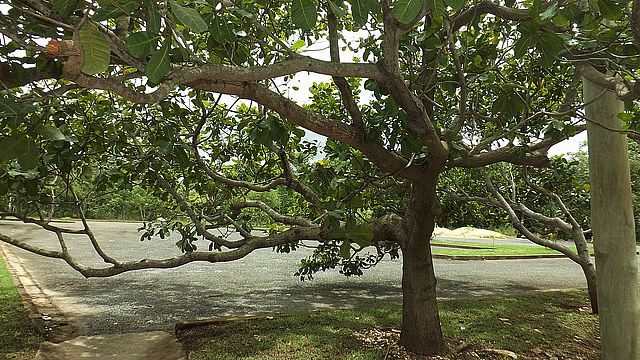The cashew tree (Anacardium occidentale) is a monoecious, fruit-bearing tree native to the coastal regions of Northeast Brazil, where it forms extensive cashew tree groves. Nowadays, the cashew tree also thrives in semi-arid regions, valleys, and along rivers, mainly in the north and northeast of Brazil, as well as in other tropical and subtropical countries. Notably, India, Tanzania, Mozambique, and Vietnam are among the world’s largest producers of cashew nuts.
The cashew tree has a broad and spreading canopy, with highly branched and contorted limbs. Its trunk features a grayish, fissured bark that peels off in plates. From it, a resin similar to gum arabic is extracted, which has various industrial applications. The leaves are large, glabrous, leathery, obovate, with well-defined veination, and a green to occasionally pinkish color, depending on the time of year they emerge. The inflorescence is of the panicle type, with small, delicate, pink to green flowers. These fragrant flowers attract bees, making them excellent for honey production.

The true fruit is gray when ripe, kidney-shaped, enclosing a large seed, the cashew nut, along with a caustic and flammable liquid, which is industrially extracted for various uses. The fruit is supported by a peduncle or pseudofruit, fleshy, juicy, soft, pear-shaped, with an astringent flavor and a thin, delicate skin, yellow, orange, or red in color.
The pseudofruit, known as cashew, is widely consumed in natura, or in the form of juices, wines, liqueurs, spirits, sweets, etc. Cashews are exceptionally rich in vitamin C, surpassing oranges, and contain considerable amounts of vitamin A, as well as minerals, fibers, and other nutrients. The nuts are a valuable product exported worldwide, generally whole, roasted or fried and salted, as a snack, but also raw or in flour form, used in sweets and traditional dishes. They are rich in nutritious oils and an important source of plant proteins, besides being delicious.

The cashew tree is excellent for home orchards and landscaping use. They can be planted in small groups to form cool groves, or in rows, as well as standalone plants. Besides the broad and leafy canopy, the twisted branches are a beauty of their own, adding a dramatic touch typical of semi-arid plants. There is also a dwarf variety developed by Embrapa, with red or yellow cashews, not exceeding 4 meters in height, suitable for pot cultivation, adorning sunny patios and yards. The cashew tree is very hardy and adaptable to different conditions, requiring no complicated management or special pruning.
It should be grown in full sun, in various types of soil, but preferably fertile and well-watered, although it is quite drought-resistant and grows in semi-arid regions. The highest yields and largest size, however, are obtained in deep, fertile, well-irrigated soils. The cashew tree also tolerates waterlogging, as long as it is not prolonged. It requires little management but responds well to fertilization and weed control.
It does not tolerate intense cold or frost. Propagation is by seeds, air layering, and grafting, sown and transplanted at the beginning of the rainy season. Seed germination can be slow and uneven, and the seedlings are sensitive to transplanting, making direct sowing in the final location advisable. Fruit production begins about three years after planting.


